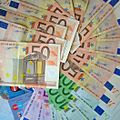European Central Bank facts for kids
 |
|
| Headquarters | Frankfurt, Germany |
|---|---|
| Established | 1 June 1998 |
| President | Mario Draghi |
| Central bank of | |
| Currency | Euro EUR (ISO 4217) |
| Reserves |
0.526 trillion euro in total
0.04 trillion euro directly
0.34 trillion euro (Eurosystem incl. gold) 0.15 trillion euro (forex reserves) |
| Bank rate | 0.00% (Main refinancing operations) 0.25% (Marginal lending facility) |
| Interest on reserves | -0.40% (Deposit facility) |
| Preceded by |
19 national banks
National Bank of Austria
National Bank of Belgium Central Bank of Cyprus Bank of Estonia Bank of Finland Banque de France Deutsche Bundesbank Bank of Greece Central Bank of Ireland Banca d'Italia Latvijas Banka Bank of Lithuania Central Bank of Luxembourg Central Bank of Malta De Nederlandsche Bank Banco de Portugal Banka Slovenije Národná banka Slovenska Banco de España |
| Website | www.ecb.europa.eu |
The European Central Bank (ECB) is like the main bank for all countries that use the euro currency. It helps manage the money for the eurozone, which includes 19 countries in the European Union (EU). This makes it one of the biggest money areas in the world.
The ECB is one of the most important central banks globally. It is also one of the seven main organizations of the EU. The central banks of all 28 EU countries own a part of the ECB. The bank was started in 1998 and its main office is in Frankfurt, Germany. Mario Draghi was the President of the ECB as of 2015. He used to be the head of the Bank of Italy.
What the ECB Does
The main job of the ECB is to keep prices stable in the Eurozone. This means making sure that prices for goods and services do not go up or down too much. They try to keep inflation (prices going up) below 2%.
Here are some of its key tasks:
- They decide how much money should be in circulation.
- They manage the interest rates, which affects how much it costs to borrow money.
- They handle money exchanges with other countries.
- They look after the money reserves of the European System of Central Banks.
- They run important payment systems like TARGET2. This system helps banks send money to each other quickly and safely.
- The ECB is the only bank allowed to print euro banknotes.
- EU countries can make euro coins, but the ECB must approve the amount first.
How the ECB is Set Up
The ECB follows European laws. It is set up a bit like a company because different national banks own parts of it. These national banks are like shareholders.
The total money invested in the ECB is about €11 billion. This money comes from the central banks of the EU countries. When the ECB started in 1998, each country's share was based on its population and how strong its economy was. These shares cannot be sold or used as a guarantee for loans.
Leaders of the ECB
The ECB has had several presidents since it started. These leaders guide the bank and make important decisions about the euro.
Here are the past and current Presidents:
- Wim Duisenberg (from the Netherlands): 1998-2003
- Jean-Claude Trichet (from France): 2003-2011
- Mario Draghi (from Italy): 2011-present
Images for kids
-
Wim Duisenberg, first President of the ECB
-
Mario Draghi, President of the ECB between 2011 and 2019
-
Jean-Claude Trichet, the second President of the European Central Bank
See also
 In Spanish: Banco Central Europeo para niños
In Spanish: Banco Central Europeo para niños











